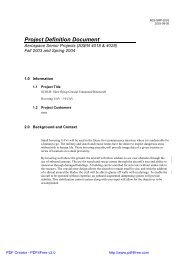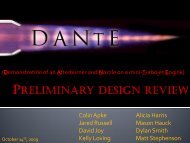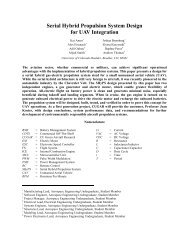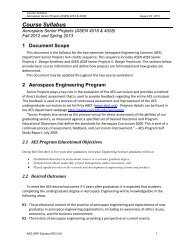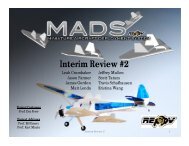PFR - Aerospace Engineering Sciences Senior Design Projects ...
PFR - Aerospace Engineering Sciences Senior Design Projects ...
PFR - Aerospace Engineering Sciences Senior Design Projects ...
Create successful ePaper yourself
Turn your PDF publications into a flip-book with our unique Google optimized e-Paper software.
Project Final Report – CUDBF April 30 th , 2009<br />
ASEN 4028: <strong>Aerospace</strong> <strong>Senior</strong> <strong>Projects</strong><br />
Figure 137: Buff-2B carrying empty water bottle payload<br />
13.2.2.11 Flight Test #17<br />
The purpose of flight test #17 was to load the aircraft with ½ the weight of the full bottle, in<br />
order to get the pilot comfortable flying with a heavier load. The payload consisted of 4.0 lbs of<br />
ballast placed in the external battery box, a payload designed for Buff-2B flights with the Lipo<br />
battery. The pilot felt this was necessary due to the extreme change in payload weight from the<br />
empty bottle (1.0 lbs) to full bottle (9.0 lbs) flight. Since the full bottle weighs more than the<br />
entire aircraft, it was important to test the CG shift and flight characteristics at a lower weight.<br />
No quantitative data was measured on this flight since it does not simulate any competition<br />
missions. The flight test was successful, and the pilot felt comfortable moving on to the full<br />
bottle payload. Unfortunately, some ground damage occurred after the flight. The full bottle<br />
flight was pushed back until the next flight test.<br />
13.2.2.12 Flight Test #18 and #19<br />
The purpose of flight test #18 was to fly the aircraft with the empty water bottle payload as a<br />
pilot warm up for the full bottle flight. After a successful landing on flight #18, the pilot was<br />
ready to attempt the full bottle flight.<br />
The goal of flight test #19 was to fly the aircraft with the full water bottle payload (9.0 lb<br />
payload weight). The two requirements that needed to be tested on this flight were the 100 ft<br />
takeoff requirement under full weight, and the average power draw at full weight.<br />
The pilot noticed steering issues during taxi tests before the flight. The weight of the full water<br />
bottle compressed the nose gear significantly, making it difficult to steer the aircraft. The pilot<br />
decided it would be safer to slowly accelerate rather than push to make the 100 ft takeoff<br />
150




